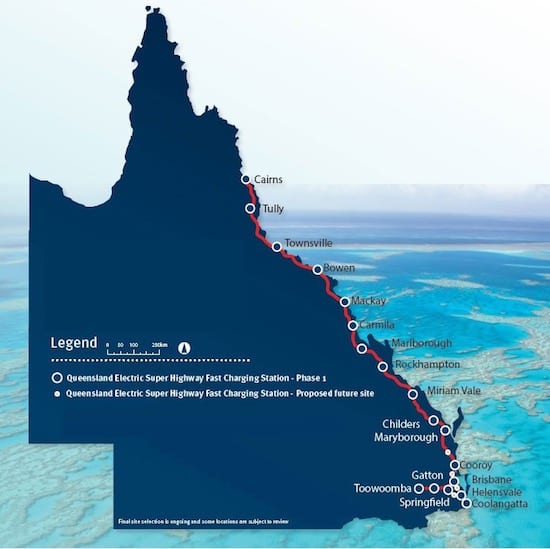The Queensland government has laid claim to the “world’s longest electric vehicle super highway in a single state” after the first phase of fast charger station installations was completed last week.
State transport minister Mark Bailey says EV drivers can now travel from Coolangatta to Cairns, and west from Brisbane to Toowoomba, thanks to the installation of charger stations at Townsville and Carmila. (Although, some more intrepid EV drivers would argue this was already possible!)
The completion of phase one of the Queensland Electric Super Highway – or QESH – means that there are now fast-charging stations installed in Bowen, Cairns, Carmila, Childers, Gatton, Hamilton, Gold Coast Airport (Coolangatta), Mackay, Marlborough, Maryborough, Miriam Vale, Rockhampton, Springfield, Sunshine Coast (Cooroy), Townsville, Toowoomba and Tully.
The next charger expected to come online will be at Helensvale, and will be operational after the Commonwealth Games.
At this stage, EV drivers can use the fast-charging stations at no cost, Bailey said, to encourage “uptake and interest in” electric vehicles. And to ensure the EVs are topped up with low carbon power, the energy supplied at the stations will be bought through green energy credits or offsets.
“We now have the world’s longest electric vehicle super highway in a single state stretching all the way up our beautiful eastern coastline,” Minister Bailey said in comments on Wednesday.
“This is literally electrifying news for Queenslanders and just one example of the innovative and strategic direction this state continues to take.”
As we reported here in July last year, many, but not quite all, of the fast chargers for the project have been supplied by local Brisbane-Based success-story, Tritium.
Tritium’s Veefil fast chargers – in particular its Veefil-RT 50kW DC model, first released in 2013 – are recognised as being among the world’s most technologically-advanced, able to recharge an EV battery in as little as 10 minutes, and have been installed in 18 countries around the globe, including a number of international EV super highways.
More recently, the company raised funds to finance the launch of three new products, including an ultra-fast, high powered charger up to 475kW; a DC charger for work places, fleets and high-density living; and a 12kW Bi-directional DC home charger.
Bailey said the Labor Palaszczuk government had a vision to encourage the uptake of EVs in Queensland, getting as many people as possible on board the EV revolution, as part of the state’s transition to a low-emissions future.
Lack of supporting infrastructure – and in particular, a lack of easy to access fast-charging stations – has been considered one of the key reasons why Australia has fallen well behind many other developed countries in its uptake of electric vehicles; although the distinct lack of supporting government policy, particularly at the federal level, has also been blamed.
“We knew our vision was ambitious, but this shift is happening around the world and unfortunately Australia is lagging behind,” Bailey said.
“The global market continues to head full-speed towards a future where electric vehicles dominate the transport space, with major manufacturers unveiling their newest models in recent expos in the United States and making major commitments to increasing the range available to consumers,” he said.
“We want Queensland to be at the forefront of these changes.
“EVs provide not only a reduced fuel cost for Queenslanders, but an environmentally-friendly transport option, particularly when charged from renewable energy.”









